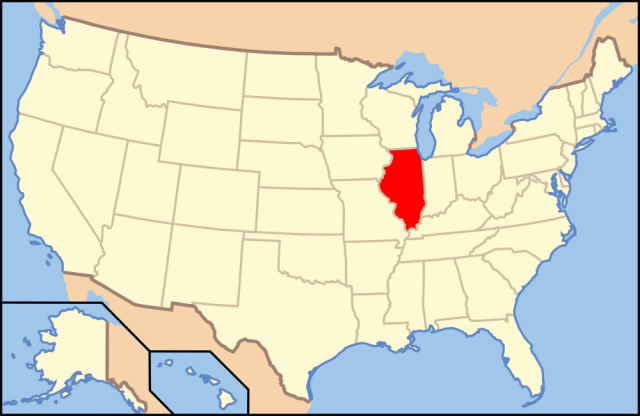The State of Illinois
AT A GLANCE
Name: Illinois is an Algonquian word meaning “tribe of superior men.”
Nickname: Prairie State
Capital: Springfield
Size: 57,918 sq. mi. (150,007 sq km)
Population: 12,859,995 (2015 est)
Statehood: Illinois became the 21st state on December 3, 1818.
Electoral votes: 21 (2016)
U.S. Representatives: 20 (until 2016)
State tree: white oak
State flower: native violet
State animal: white-tailed deer
Highest point: Charles Mound, 1,235 ft. (376 m)

THE PLACE
Illinois is often called the Prairie State because much of the state is covered by gently rolling plains. Most of these plains were created when glaciers leveled the midwestern portion of the country thousands of years ago. Illinois's plains are rich agricultural lands suitable for growing a variety of crops. The southern part of the state is known as the Shawnee Hills and is more hilly and forested than the plains region. Illinois has 63 miles (101 km) of shoreline on Lake Michigan, one of the Great Lakes. Chicago is Illinois's largest city and the site of the state's chief port.
Summers in Illinois are hot, while winters can be very cold. The Lake Michigan shoreline region is the coldest and snowiest area of the state. Tornadoes have killed more people in Illinois than in any other state. Illinois has one of the largest bituminous, or soft, coal deposits in the world. More than two-thirds of the state lies over a gigantic soft coal bed. The southeastern part of the state is rich in petroleum deposits.
Facts and Firsts
- In 1865, Illinois became the first state to approve the 13th Amendment to the Constitution, which made slavery illegal.
- In 1885, the world's first metal-framed skyscraper, the Home Insurance Building, was built in Chicago.
- The first successful nuclear fission reaction took place at the University of Chicago in 1942, when Enrico Fermi and other scientists proved that it is possible to produce heat using the materials graphite and uranium.
- The first McDonald's restaurant opened in Des Plaines in April 1955.
- The Chicago Public Library, with more than 2 million books, is one of the largest public libraries in the world.
THE PAST
Thousands of burial mounds created by prehistoric Native American cultures still exist in Illinois today. The descendants of these early Native Americans eventually formed several tribes that make up the Algonquian family.
The first Europeans to see Illinois were probably Father Jacques Marquette and Louis Jolliet (1673), who were exploring the Mississippi River region for the French governors of Canada. The French began to settle the region, but war broke out with the British, who claimed all the land west of their American colonies on the East Coast. The British won the Illinois territory in 1763. During the Revolutionary War, the Americans took control of Illinois from the British, and the area remained a U.S. territory until its statehood became official in 1818.
After statehood, many people began to settle in the northern part of Illinois, and the city of Chicago grew. In 1825, the Erie Canal opened a transportation route to the Midwest from the east, and by 1830 the state's population had tripled. Illinois gained fame during the Civil War because President Abraham Lincoln spent most of his life there, and Union general Ulysses S. Grant was living in Illinois when the war began in 1861.
The post–Civil War construction of railroads stimulated the growth of industry and attracted many European immigrants to Illinois. Manufacturing and farming in Illinois exploded. Chicago quickly became the center of the meat-packing industry.
The discovery of new oil fields in southwestern Illinois in 1937 brought an oil boom to the state. Illinois quickly became one of the richest midwestern states, and Chicago grew to be a manufacturing center as well as a leading site for scientific research. The state's rapid expansion also produced negative consequences, including pollution and traffic problems.
THE PRESENT
Chicago, one of the largest cities in the world, is home to about half of Illinois's total population. The city is also an industrial and transportation center. Many major companies, including McDonald's, Sears Roebuck, and United Airlines, have their corporate headquarters in the area. Chicago is the second most important manufacturing area in the nation. It is also the international center for the study of atoms.
Illinois is a leading agricultural state as well, with about three-quarters of its land devoted to farming. The most important crop is corn, followed by soybeans, wheat, and hay. The raising of hogs and cattle is also a significant contributor to Illinois's agricultural economy. The state's coal and petroleum resources help to diversify its economy.
Born in Illinois
- Jane Addams, social worker
- Ray Bradbury, author
- Christine Brewer, opera singer
- William Jennings Bryan, lawyer, politician
- Edgar Rice Burroughs, author
- Raymond Chandler, author
- Hillary Rodham Clinton, U.S. senator and first lady
- Miles Davis, musician
- Walt Disney, film animator and producer
- Bobby Fischer, chess player
- Betty Friedan, feminist
- Benny Goodman, musician
- John Gunther, author
- Black Hawk, Sauk chief
- Ernest Hemingway, author
- Wild Bill Hickok, scout
- Frederick Maytag, inventor, manufacturer
- Bill Murray, actor
- Ronald Reagan, actor, U.S. president
- Carl Sandburg, poet
- Sam Shepard, playwright